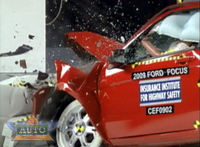Automakers Achieve Enhanced Safety with Voluntary Commitment's September 1st Milestone
SEE ALSO: Crash Test Ratings database
New Car Buyers Guide
WASHINGTON - August 27, 2009: Automakers have now successfully implemented a voluntary agreement under which new cars and light trucks are engineered to be more compatible in front and side-impact crashes. Since launching the agreement, manufacturers have been quickly increasing the percentage of vehicles with the compatibility engineering, and as of September 1, 2009, 100 percent of each participating manufacturers' applicable vehicles will be made in a way that improves crash compatibility.
The voluntary 2003 agreement involves BMW, Chrysler, Ford, General Motors, Honda, Hyundai, Isuzu, Kia, Mazda, Mercedes-Benz, Mitsubishi, Nissan, Subaru, Suzuki, Toyota and Volkswagen. Insurance Institute for Highway Safety (IIHS) field studies support the substantial real-world benefits of the re-designed vehicles. The fatality rate of belted car drivers in frontal crashes with 2000-03 model light trucks during 2000-04 was 19 percent lower when the light trucks already met the criteria than when they did not. The research also found a 19 percent reduction in car driver fatality rates when the cars were struck in the side by light trucks meeting the criteria.
The Alliance of Automobile Manufacturers and the Association of International Automobile Manufacturers (AIAM), which together represent virtually 100 percent of U.S. vehicle sales, entered into the agreement with input from the IIHS. The three parties have reported the agreement's success to the National Highway Traffic Safety Administration (NHTSA).
"This voluntary agreement is actually a model for responsible action on behalf of automakers to improve occupant safety," said Alliance President and CEO Dave McCurdy. "Participating automakers entered into this agreement at the end of 2003, and immediately began working to implement the enhancements. Just six years later, 100 percent of the vehicles involved in this commitment have now been engineered according to the agreement's performance criteria. That's very quick action given the major structural changes that have been made to benefit the vehicle occupants."
The performance criteria enhance occupant protection in front- and side-impact crashes by better matching the front structural components of different vehicles. Better matching of structural components enhances the vehicle's ability to manage and absorb crash energy. To improve head protection in cars struck in the side, the automakers installed head-protecting side airbags. IIHS research indicates that side airbags with head protection are reducing driver fatality risk by about 37 percent in crashes involving the driver's side of the vehicle.
"The automakers researched this issue, identified ways to reduce the risk, and agreed to appropriate measures - and they did this all faster than the government could have through regulations," said Adrian Lund, president of IIHS. "This doesn't mean colliding passenger vehicles now are compatible in every crash, but it does mean car occupants are less likely to be injured or killed in crashes with SUVs and pickup trucks."
"The progress made by voluntary agreements such as this demonstrates how important cooperative efforts can be in support of customer-oriented outcomes," said Michael J. Stanton, president and CEO of the AIAM. "We're pleased with the success we've achieved in vehicle crash compatibility and welcome opportunities to participate in voluntary programs that can deliver results more quickly than the traditional route of legislation and rulemaking."
All groups agree that consumers will derive the greatest benefits from the compatibility commitment when using their safety belts.
Crash compatibility is just one of many voluntary industry commitments developed by automakers and international safety expert groups. For example, a 2000 voluntary safety commitment to enhance side-airbag performance was developed by the Alliance, IIHS, the Automotive Occupants Restraints Council, and AIAM.
The Alliance of Automobile Manufacturers is a trade association of 11 car and light truck manufacturers including BMW, Chrysler, Ford Motor Company, General Motors, Jaguar Land Rover, Mazda, Mercedes-Benz, Mitsubishi, Porsche, Toyota and Volkswagen.
The Association of International Automobile Manufacturers, Inc. (AIAM) is a trade association representing 13 international motor vehicle manufacturers, including Aston Martin, Ferrari, Maserati, Honda, Hyundai, Isuzu, Kia, Mitsubishi, Nissan, Peugeot, Subaru, Suzuki and Toyota. AIAM member companies account for 40 percent of all passenger cars and light trucks sold annually in the United States and 36 percent of U.S. light vehicle production.
The Insurance Institute for Highway Safety is an independent, nonprofit, scientific, and educational organization funded by auto insurers with the mission of reducing the losses -- deaths, injuries, and property damage -- from crashes on the nation's highways.



